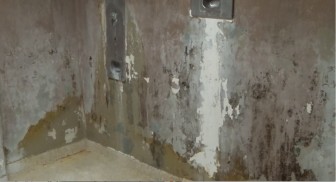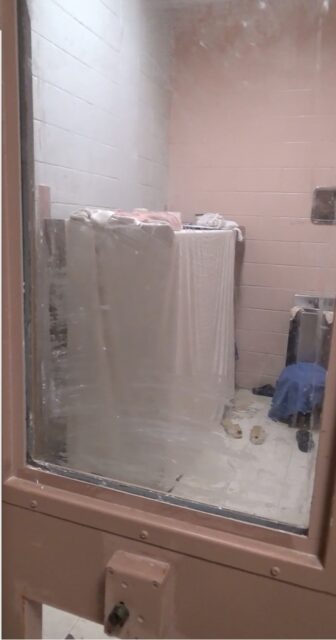
Shattered glass on cell doors, sewer gas, inadequate security, broken showers, pervasive mold and filth: The conditions inside Orleans Parish Prison were the subject of another federal court hearing on Monday, this time about how mentally ill inmates are treated.
The hearing was focused on finding a short-term plan to house inmates who are now in the jail’s Templeman V facility. Consent decree monitors described the conditions in the building, saying they’re completely unsuitable for people with serious mental illnesses.
How the jail handles such prisoners is a key part of the consent decree outlining reforms at the jail, particularly since the sheriff and city officials have acknowledged that a brand-new facility isn’t designed to handle inmates with the worst mental-health conditions.
In an opening statement Monday, U.S. District Judge Lance Africk noted that there is no disagreement among any of the parties — the plaintiffs, the Sheriff’s Office and the city — that the current state of mental health care at the jail is not in compliance with constitutional standards.
“The importance of a temporary solution is underscored by recent media reports of an inmate assaulting a guard with a shank,” he said. “The Orleans Parish Prison is a dangerous place.”
“You don’t put psychotic people in a dormitory with other people when they are misperceiving reality. It is a recipe for disaster.”—Dr. Raymond Patterson, mental health monitor for OPP consent decree
For more than a year, the plaintiffs in the lawsuit — the U.S. Department of Justice and attorneys representing inmates — have called for immediate action on mental health care. In a joint filing last week, the plaintiffs characterized living conditions at Templeman V as “abysmal.”
Sheriff Marlin Gusman has proposed moving mentally ill inmates to a state corrections facility for up to three years while he renovates two buildings at the jail. He wants the city to pick up the entire cost, which could cost millions a year.
The cost of the consent decree —estimated to cost at least $10 million per year, and possibly as much as $22 million — has been a subject of intense debate between Gusman and New Orleans Mayor Mitch Landrieu. Gusman listed Landrieu on his list of witnesses for Monday’s hearing, but attorneys for the city objected, and Landrieu wasn’t called to testify.
Witnesses describe filth, lack of supervision

In testimony, Susan McCampbell, the lead monitor, presented a video she recorded inside Templeman V. Inmates with the most serious mental-health needs — including those who pose a danger to themselves or others — are now housed in a severely dilapidated part of the jail, she said.
“The cleanliness of the unit is not to standard by any means,” she said. As an image of a shower covered with grime and mold was displayed in court, she added, “This is the condition of the shower, which your honor has seen. I don’t have much to say about that except that it’s appalling.”
The problems with Templeman V are not limited to its physical condition. Severely mentally ill inmates, including suicidal inmates who are supposed to be under constant supervision, are allowed to cover their cell windows with soap to obscure guards’ view. One had used sheets and other materials to create what she described as a “cocoon” around his bunk.
Dr. Raymond Patterson, McCampbell’s mental health monitor, testified that the layout of units in the facility — lines of cells with no central observation post — effectively hides some inmates from supervision.
Later in the hearing, Gusman’s Chief Deputy Jerry Ursin testified that Templeman V’s “physical plant is not laid-out well.” Ursin also said the building lacks suicide-resistant cells.
“There were a number of inmates under direct observation where the officers could not possibly see them,” Patterson said.
He added that in other parts of the building, delusional inmates were held in dormitory style cells.
“You don’t put psychotic people in a dormitory with other people when they are misperceiving reality. It is a recipe for disaster,” Patterson said.
Gusman’s short-term fix
The sheriff has proposed a three-part plan to deal with mentally ill inmates, which involves moving some of them to a prison 70 miles away, renovating two parts of the jail to deal with others, and then building a new facility to house everyone.
The first part would be to move male inmates with acute mental illnesses — defined as those suffering from severe disorders that require intensive care — to the Elayn Hunt Correctional Center in St. Gabriel, 70 miles away, for up to three years.
So-called “sub-acute” male inmates — those who are responding well to treatment but are not yet ready to join the general population — also would be housed at Elayn Hunt while the Sheriff’s Office retrofits part of the jail’s Temporary Detention Center for them.
Hunt can’t take female inmates. So for the short-term, Gusman wants to house female inmates with mental illnesses at the Temporary Detention Center. In fact, said Blake Arcuri, Gusman’s attorney, the Sheriff’s Office already moved them there earlier this month.
They would go to the first floor of Templeman V sometime next year after it’s renovated.
When Gusman filed his plan with the court, there were only four female inmates with acute and sub-acute mental health conditions.
Millions to renovate buildings for short-term fix
Gusman’s plan would cost $4 million up-front for equipment and renovations. That includes as much as $3.6 million in renovations to Orleans Parish Prison over the next nine months. The remaining $400,000 would go to equipment and renovations at Hunt, based on estimates from architect Jerry Hebert, who also designed the parish’s new jail building currently under construction.
The city’s only witness on Monday, Director of Capital Projects Vincent Smith, testified that the estimate was likely too high but offered few significant rebuttals, saying he hadn’t prepared his own estimate. One part he criticized was a proposed $30,000 architecture and engineering fee. He said he would have set it at $24,000.
Ongoing operations at Hunt could cost as much as $2.4 million per year. In a motion filed last week, Gusman asked Africk to approve his short-term mental health plan and order the city to pay for it. Africk didn’t say when he would rule on the motion.
$4 millionTo renovate OPP and Elayn Hunt for short-term housing$2.4 millionAnnual cost to house inmates at Elayn Hunt
The city objects to the plan, saying it will take money away from other priorities, including its abilities to provide mental health services to residents who are not in jail.
Gusman’s short-term plan to house inmates at Hunt could cost more than $400 per inmate per day, “more than a stay at the Windsor Court hotel,” said former U.S. Attorney Harry Rosenberg, who is representing the city, in Monday’s hearing.
Rosenberg repeatedly brought up the city’s budget problems. But Africk stressed the need to provide constitutional care under the terms of the consent decree he approved.
Referring to the city’s objections over cost, Africk said at one point, “This argument was considered when the court entered the consent decree, which I found narrowly tailored.” The judge then told Rosenberg to drop the line of questioning.
New jail building for mentally-ill inmates?
Testimony at the hearing was limited to the short-term. Long-term housing for the mentally ill is another question entirely, and the answer could be even more expensive.
Gusman ultimately hopes to house mentally ill inmates in a third facility on an undeveloped lot between the new, $81.5 million kitchen/warehouse that opened last year and a $145 million housing and intake building now under construction.
In approving the latter facility in 2010, the New Orleans City Council limited the jail’s capacity to 1,483 beds. The ordinance also called for the building to handle any type of prisoner including inmates that need treatment for substance abuse and mental health — but excluding those with acute or sub-acute mental health conditions.
The jail’s population has averaged around 2,000 even as Gusman has shut down buildings. For years, Gusman has lobbied the city for a controversial “Phase III” building with several hundred more beds.
Now, with the new facility and Templeman V considered unsuitable for inmates with serious mental health issues, Gusman has floated “Phase III” as a solution to the jail’s long-term medical and mental health care needs.
After previously offering support for the Phase III building, the Landrieu administration now opposes the plan. Its counterproposal involves the renovation of the fourth floor of the building now under construction.
That would take nearly a year and cost $6 million, according to preliminary projections offered in a June 25 court filing. Gusman believes construction on the fourth floor would require a temporary closure of the third floor, further straining capacity.
Court monitor: Jail probably undercounts mentally ill inmates
Rosenberg presented a chart showing the daily population of inmates under suicide watch and direct observation in Orleans Parish Prison in June. It went as high as 28 on June 13 but averaged 18, Rosenberg said.
Patterson and McCampbell, however, said those figures are too low. For example, Patterson said, that doesn’t include psychotic inmates. And the Sheriff’s Office’s psychological screening is below standards and likely misses a number of seriously mentally ill prisoners, McCampbell said.
“So while these numbers are interesting, they’re probably grossly inaccurate,” she said.
Later, when Rosenberg cited those estimates again, Africk said they were misleading.
“I have to say that after hearing what Dr. Patterson had to say, I don’t believe those numbers are accurate,” Africk said.
“You keep talking about 14 inmates or 18 inmates or whatever. I don’t know if you’re doing that for the courtroom or the press, but it’s not flying with me,” he said. “However many inmates there are, there has to be mental health care for those inmates.”

